
Reference Publication: Parker, D S and M P Callahan (1999. )Energy and Resource Assessment of the Caribbean Marine Research Center, Lee Stocking Island. FSEC-CR-1085-99, Florida Solar Energy Center, Cocoa, FL. Disclaimer: The views and opinions expressed in this article are solely those of the authors and are not intended to represent the views and opinions of the Florida Solar Energy Center. |
Energy
and Resource Assessment of the
Caribbean Marine Research Center,
Lee Stocking Island
Danny
S. Parker and Michael P. Callahan
Florida
Solar Energy Center (FSEC)
FSEC-CR-1085-99
Executive Summary
A project is being coordinated by the Florida Solar Energy Center (FSEC) with the Perry Foundation and the Caribbean Marine Research Center (CMRC) on Lee Stocking Island in the Bahamas. The purpose of the research is to demonstrate energy and water savings associated with efficient technologies in an isolated sub-tropical climate. The project is being used as a test case to examine how energy and resource independent eco-tourism projects might be successfully accomplished in Florida and other Caribbean locations.
FSEC plans to monitor energy and water consumption in two buildings at the center. The VIP (Scientists' quarters) building has been selected for monitoring because this building has high occupancy during much of the year. The facility is also very similar to other housing units so that 'lessons learned' can be applied elsewhere on the island. This building will be monitored for various temperatures, total energy consumption, air conditioning consumption, water use, and roof water production.
The other building to be monitored is the kitchen and lounge/dining area. Energy use is high due to food preparation. Comfort is also an issue since visitors to the island eat their meals in the dining area. This building will be monitored for total and overhead lighting/ceiling fan energy consumption as well as interior comfort levels. Hot water consumption for the two buildings will also be monitored since both share a common water heater.
Our preliminary visit to the island on February 17-19, 1999 revealed several issues and opportunities at CMRC. Each is presented more fully within the report:
-
Diesel generators currently provide all power for the island. Maximum electrical demand is approximately 80 kW varying from a minimum of 19 kW depending on time of year, occupancy and temperature conditions. Annual diesel oil consumption is estimated at approximately 35,000 gallons per year. The incremental cost for electricity generation is approximately $0.13/kWh not including generator equipment maintenance or amortization.
-
Improved control of pumps and air conditioning systems could provide reduction to the annual fuel requirements for the island.
-
Total facility fresh water demand averages 2,500 gallons per day. Needs are currently satisfied by reverse osmosis of sea water - an energy and maintenance intensive process.
-
Termites are a major problem on the island. Even with constant pest control and spraying, maintenance cannot keep up with degradation of non-treated wood products. Building life is compromised and structural maintenance is increased. These problems argue for all-concrete construction.
-
Metals suffer extensive corrosion in the island's high salt environment. Wall and window air conditioners generally last 3 years. This problem also argues for concrete construction.
- There are several cisterns for rain water collection on the island,
although some are not utilized. Cistern water production using
all of facility roof space could potentially provide more than
half of facility water needs.
- There are approximately 4.5 kW of photovoltaic modules available
for use on the island that are not currently connected to the island
power grid.
- There are a dozen solar hot water heater panels in storage that
should be used to retrofit all island water heating systems using
a standardized two-tank system. Virtually all water heating could
be accomplished with such systems.
- Location of refrigeration units in a outdoor room and an effective range hood over the cook top can significantly improve comfort in the kitchen and dining areas.
-
All concrete construction with white roofs
-
Integral water collection cisterns
-
Wide eight foot surround porches
-
Energy efficient lighting
-
Double glazing for windows
-
Solar water heating
-
Most efficient refrigerators of the size and type required. Preferably units should be located outside the conditioned space in an attached utility room.
Baseline monitoring in the project should begin in the summer of 1999 with improvements sequenced over time to gauge their specific impact.
Introduction
FSEC personnel visited the Caribbean Marine Research Center (CMRC) on Lee Stocking Island in Exumas, Bahamas (Figures 1 and 2) from February 17th - 18th, 1999. The project hopes to learn about practical issues associated with eco-tourism projects which may have wide application in Florida and remote parts of the Caribbean. A previous survey examined the energy related circumstances at LSI (Sonne, 1997).

Figure 1. Aerial view of the island (courtesy of CMRC).
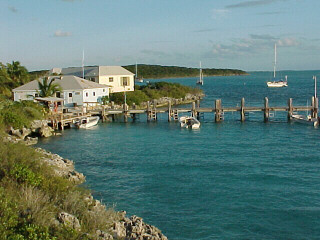
Figure 2. View of the island
The intent of the project is to learn about the energy and water producing facilities on the island in greater detail and to audit their operating characteristics. We plan to make future improvements which will reduce dependence on outside resources.(1)
Weather Data
A meteorological station is located on the island as part of the Caribbean Planning for Adaptation to Global Climate Change (CPACC) project. The station collects data including temperature, humidity, wind speed and rainfall. The data is theoretically available over the Internet from its satellite downlink, but the data transfer seems unreliable and can not be easily obtained. However, since 1990 CMRC has maintained it's own weather station (Figure 3) to collect meteorological data and a summary of the month-by-month averages from the last year is given in Table 1. The weather is warm, but dry with considerable wind (prevailing wind direction is from the southeast).
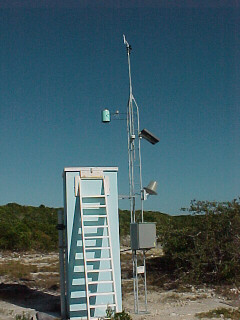
Figure 3. Weather station at CMRC.
Table 1 Average Weather Conditions at Lee Stocking Island, 1997
| Month | Minimum Temp. (oF) |
Maximum Temp. (oF) |
Mean Temp. (oF) |
Relative Humidity (%) |
Wind Speed (m/s) |
Maximum Wind Speed (m/s) |
Actual Rainfall (inches) |
Light (cal./cm2) |
| Jan | 70.3 | 78.4 | 74.0 | 68.1 | 3.8 | 6.8 | 2.4 | 288.1 |
| Feb | 73.4 | 81.9 | 76.8 | 64.9 | 4.9 | 7.4 | 0.5 | 389.1 |
| Mar | 72.4 | 82.0 | 76.6 | 68.6 | 4.1 | 7.0 | 0.7 | 439.4 |
| Apr | 72.6 | 81.9 | 77.0 | 67.0 | 3.8 | 6.6 | 1.5 | 460.0 |
| May | 76.8 | 86.1 | 80.9 | 69.5 | 3.6 | 6.1 | 1.3 | 485.6 |
| June | 77.9 | 86.4 | 82.0 | 61.5 | 3.2 | 6.1 | 7.1 | 409.3 |
| July | 79.3 | 89.4 | 84.0 | 67.7 | 3.9 | 6.7 | 4.7 | 435.7 |
| Aug | 80.4 | 90.0 | 84.7 | 70.4 | 3.4 | 6.4 | 1.8 | 445.6 |
| Sept | 79.4 | 87.3 | 83.3 | 67.9 | 3.1 | 6.6 | 2.4 | 365.6 |
| Oct | 78.0 | 84.0 | 80.9 | 70.9 | 4.0 | 7.1 | 3.6 | 362.3 |
| Nov | 75.5 | 81.8 | 78.7 | 66.1 | 3.7 | 6.9 | 5.7 | 246.6 |
| Dec | 73.3 | 80.3 | 76.6 | 72.9 | 2.9 | 5.6 | 0.6 | 262.6 |
| Year | 75.8 | 84.1 | 79.6 | 68.0 | 3.7 | 6.6 | 32.3* | 382.5 |
* Total rainfall for 1997. Monthly average = 2.7"
Diesel Power Generators
Diesel generators provide electric power for the island. The old units were 671 Detroit diesels. One failed after having 29,000 hours of use. Maintenance is important: a generator operates for 336 hours between oil changes. After the loss of the old unit, a new generator was purchased. This was done since a fully reconditioned 671 Detriot cost $10,900 + $3000 for transport. The cost of a new generator was $14,000, not including transport from Marathon Key.
The old generators used 130 gallons of fuel per day (gpd) under light loads and 168 gpd under heavy loads. The new generators use less than 100 gpd under light loads. Power is 480 Volts, three phase. Light loads on LSI are approximately 40 amps (480 x 40 = 19 kW) while heavy loads during summer are about 140 amps (480 x 140 = 67 kW).(2) The capacity on the new generator is 198 amps. When examined at 5 PM on 2/18/99 the power draw was 50 amps at 480 volts.
Generator Data:
Model: P-150E
Manufacturer: F.G. Wilson, Ltd.
Max Output: 198 amps @480 volts: 3 phase 60 Hz
Specifications: 165 kVA, 132 kW, 1800 rpm
At 50 amps peak load the lower consumption value is seen while the higher figure is seen at a 140 amp peak demand. The average demand over the daily cycle is likely less than the peak value so the average for low consumption days might be 40 amps and 100 amps at the higher consumption level. Specific performance data for the P-150E generators, obtained from F.G. Wilson, Ltd., indicates that the new units have better unloading characteristics:
P-150E Generating Set Fuel Consumption: L/hr (US gal/hr)
| Frequency | 100% Load | 75% Load | 50% Load | 25% Load |
| 60 Hz | 40.4 (10.7) | 30.9(8.2) | 20.8(5.5) | 11.3 (3.0) |
Since full load is 198 amps at 480 volts, 75% load is 149 Amps and 50% is 99 amps. Based on manufacturer's data fuel consumption can be computed to be a linear function of load:
Gallons/hr = 0.34 + 10.4(PLR)
Where: PLR = part load fraction (0 - 1)
This same data can be used to estimate the incremental cost for electricity generation using the new generators:
Table 2. Specific Generator Diesel Fuel Consumption.
| Case Description | Average Current | Average kW Demand | Part Load Ratio | Fuel Use |
| High Demand | 140 amps | 67.2 kW | 0.707 | 7.70 gph |
| Low Demand | 40 amps | 19.2 kW | 0.202 | 2.44 gph |
| Difference | 100 amps | 48.0 kW | 0.505 | 5.26 gph |
Delivered diesel fuel costs $1/gallon. Thus, the cost of producing the base electricity consumption is $0.13/kWh - about 50% higher than conventional generation in Florida. However, the loading characteristics of the diesel generator are such that the cost of producing another 48 kWh is about $5.26 or about $0.11/kWh.(3) Thus, every kWh saved will reduce fuel related operating costs by about eleven cents. Assuming that a typical hot summer day ranges between the low and high loads, the average daily peak diesel fuel consumption should average about 120 gallons.
Actual fuel consumption was carefully tracked for a seven day period ending March 3rd, 1999. The loads during the period varied from 50 - 90 amps with total consumption of 547 gallons or 78 gallons per day. Assuming the average load was 70 amps (PLR=0.35), the relationship established above would estimate four gallons used per hour or 96 gallons per day. Although 23% greater than that estimated, this is well within our knowledge of the true loads which may have averaged closer to 50 amps than 70. Back calculating the average load from 78 gallons per day would show average PLR to be 0.28 or 56 amps over the period. This check gives some confidence that the manufacturer's published performance data is reasonably accurate.
Fuel is available in two large storage tanks (Figure 4) which hold roughly 12,000 gallons of diesel fuel and 4,000 gallons of gasoline. Diesel fuel cost is approximately $1.00 per gallon (duty free).(4) Gasoline is used primarily for boats (CMRC maintains 10 boats). The storage tanks are re-fueled every six weeks.
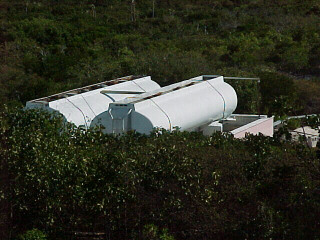
Figure 4. Diesel fuel storage tanks.
Sea Water Pump
The pumps for the LSI aquaculture facility are always on. This facility is in disrepair and has not been used in some time.
A 7.5 hp motor circulates sea water through the system constantly, but is not currently in use. The approximate load on the system is large. With typical motor/drive efficiency, a 7.5 hp pump will draw about 12 kW. Thus, this pump (Figure 5) is about 25% of the base load electricity use on the island and represents about 20 amps of load at 480 Volts. Its constant operation is also unneeded at the present time.
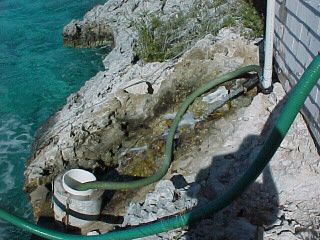
Figure 5. Sea water pump.
Recommendation: The sea water circulation pump should only be powered during evening hours (midnight until 4 AM) to prevent buildup of barnacles and other biota that may foul the system. This will avoid the daytime peak demand. A simple timer can be used. If no further use of the facility is planned, the operation of this pump should be discontinued as it represents a large load.
Reverse Osmosis Water Production System
The reverse osmosis facility is responsible for the creation of freshwater for the island. One pass water is often used for washing clothes, showers, toilets, and watering vegetation while two pass water is used for drinking and cooking. This is an energy expensive procedure and is aided by cistern water collection. It would be further aided by all existing cisterns being made ready for use, and additional water collection technology.
Power for operation of the reverse osmosis (RO) system (Figure 6) consists of the necessary pumps for the desalinization system. This consists of a 10 hp, 1000 psi diaphragm pump; a 1 hp salt water pump to bring salt water up to the facility and a 3 hp boost pump to maintain pressure within the RO system.
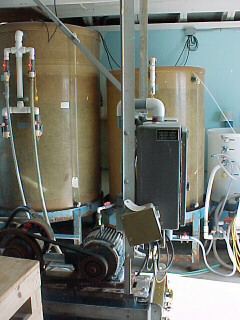
Figure 6. The reverse osmosis system.
Fresh water distribution is provided by pumping: typically A.O. Smith 3/4 hp pumps which provide pressure for showers. Pressure is not always adequate under heavy use.
Currently, RO water production averages 2.25 gallons per minute (gpm) five or six days a week for single pass. Double pass RO averages 10 gallons per hour for approximately 16 hours per week. Single pass water production for the facility to meet fresh water needs is estimated to average 2,546 gallon per day. Double pass water production is approximately 23 gallons per day.
Recommendation: Operation of the RO facility is vital as it provides fresh water for the island. However, the 3 hp boost pump is considerably over-sized. When in need of replacement, a 3/4 hp boost pump should be substituted. Also, the cistern system on the island should be expanded with connection of all existing cisterns to water supply to take advantage of their water collection. Where cisterns are not used, inexpensive "rain barrel" systems should be considered. With the replacement of current roofs with white metal roofs, the run off should be connected to cisterns or rain barrels. Rain barrel water can be used for various gardening and other non-potable needs.
Water Heating
Water heating on the island is accomplished using standard electric resistance water tanks. Tanks are typically shared between building with long plumbing runs. Most of the pipes run underground and are not insulated or are poorly insulated.
The kitchen is served by an 80 gallon tank (81VR-80-1 solar ready) with two 4500 W elements (Figure 7). The thermostat is set to 140oF. Each system draws 9 amps at 480 volts when the elements of a water heater are activated.
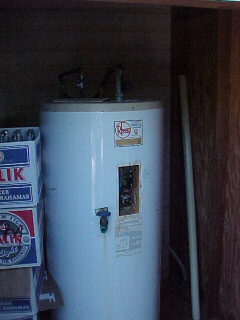
Figure 7. Solar ready kitchen hot water heater (80 gallon).
During periods of heavy facility use, water heating is likely a significant part of late afternoon/early evening loads when large groups return to their quarters to shower. For example, three water heaters operating at the same time will exert a demand on the power generation system of 27 Amps.
Potential for substitution of solar water heating is very high. A listing of the water heaters on the island was prepared by Jim Tryzbiak (Table 3). Nine of the units are electric resistance, while only a single unit is solar. Several solar systems, although operating, are not connected (Figure 8).
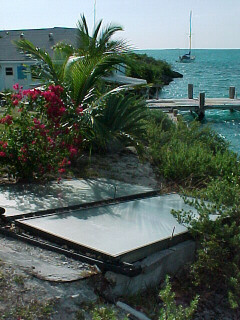
Figure 8. Unconnected solar water heating system.
Table 3. LSI Water Heater Inventory
| Location | Size |
| Bay Villa | 40 gal |
| Conch Cottage | 40 gal |
| Office Apt/Pizza Hut | 40 gal |
| Commissary Apt/ Lizard Lounge/ Kitchen/VIP | 80 gal |
| Bahama House/ Pink House | 40 gal. |
| Main Lab | 3 gal demand water heater |
| Hill House | 40 gal |
| Sunrise/Sunset | 40 gal |
| Long House | 12 gal |
| Beach Cottage/Cave | 80 gal Solar system |
Recommendation: All the water heating on the island should be revamped over time as the systems need repair or replacement. They should be changed to a two tank solar water heating system with a primary solar tank (40 gallon) with an elevated auxiliary tank with only the upper elements powered. There are currently a dozen 4 x 10 ft solar collectors (Solar Development Inc., SDC8W) in storage on the island, still located in their original shipping container and un-utilized (Figure 9). Use of solar water heating could virtually eliminate this load on the island.
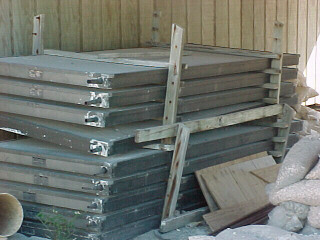
Figure 9. Unopened solar collectors for water heating still
in shipping crate.
Water Distribution System
Seven AC pumps (Table 4) are used about the island to maintain water pressure at the various buildings. Typically these are A.O. Smith 3/4 hp pumps (C48KDB11A16) which draw 5.7 amps at 230 volts (Figure 10). The large number represent a significant load:
Table 4. Water Pressurization Pumps.
| Pump # | Location | Horsepower |
| 1 | Bay villa | 3/4 |
| 2 | Conch cottage/Perry house | 1/2 |
| 3 | Pizza hut/office | 3/4 |
| 4 | Lizard lounge/VIP/Commissary Apt | 3/4 |
| 5 | Bahama House/Lab | 2 |
| 6 | Point: Sunset/Long House/Cave Beach Cottage/Hilltop | 3/4 |
| 7 | Commissary Apartment | 1/2 |
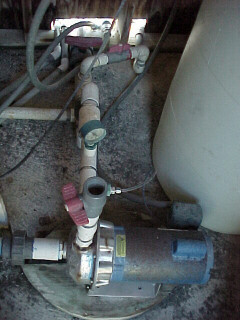
Figure 10. Distribution pump.
Cisterns
Many of the older buildings have cisterns; for instance the older Perry house and another located just south of the commissary. The commissary cistern (Figure 11) is fed by PVC piping from the Commissary apartment roof, the VIP quarters and from the Kitchen/Lounge. The cistern under the commissary is not currently utilized! The cistern measures 48 x 128 with the water up to a 54" depth. Each cubic foot of water stored is approximately 7.5 gallons, so that the cistern currently holds 193 ft3 of water or roughly 1,450 gallons which is not currently used.
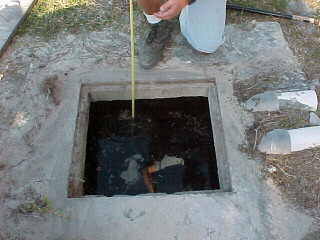
Figure 11. Cistern at the commissary.
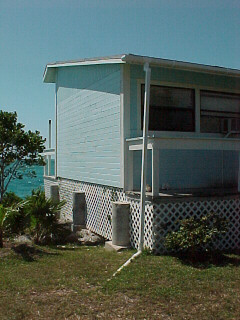
Figure 12. Gutter system on the VIP quarters that feeds rain
water to the cistern by the commissary.
The cistern shared by a staff house (Pizza Hut east) and the office/apartment is 171" x 221" with a water depth of 65 inches. This cistern currently holds 1,471 ft3 of water or 10,657 gallons.
Measured data from the past year shows the island received about 32.3 inches of rainfall. Table 1 summarizes this data by month. A quick calculation shows that utilization of cistern water has considerable potential. Assuming the 30 buildings on the island have about 1500 square feet of useful roof area that could feasiblely be used for cistern rainwater collection with a 75% collection rate, this amounts to roughly 680,000 gallons of rainwater which could be collected annually - 1,850 gallons per day.
There is 7.5 feet of water in the Beach Cottage cistern - about 2,400 gallons of water. The salt level in cistern water is about 200 ppm. A 3/4 hp pump maintains pressure for the system. The kitchen area has two 40 W cool white fluorescent lamps which are not switched and cannot be turned off (0.2 amps of load at 480 Volts which serves no purpose). Since annual RO water production at the facility totals about 929 thousand gallon per year, this indicates that over 60% of the facility water requirements could be met with expanded utilization of cisterns.
Buildings and Facilities
Hatchery
The fish hatchery raised Tilapia sp. from eggs and provided fish to fish farms. The facility functioned for a five year period. It operated under previous contracts which have expired. The hatchery was shut down in 1995 and has been abandoned since (Figure 13).
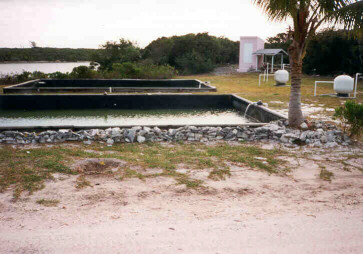
Figure 13. Pumping of an unused aquaculture facilities.
Commissary
Upstairs apartment; Refrigerator draws 0.3 A for fan and 1.7 A with compressor powered: 211 W. Ceiling fans are left on.
Lower floor has extensive refrigeration in food storage area. Space exhaust fan seems oversized and runs constantly (~300 W); nighttime operation likely pulls in excessive moisture. There is no reason to leave ceiling fans on when the space is not occupied. Each fan uses 20 - 50 W when left on.
Recommendation: Substitute PV power vent fan for commissary storage. This will reduce moisture laden air which is pulled in through storage area during nighttime periods. This will also reduce noise levels in the outside area.
Long House
Has 12 gallon water heater which is constantly on regardless of whether it is in use. We unplugged the tank; it should be placed on a manual switch.
Cave
The Cave has a propane stove. Propane costs $56.00 for a 100 lb. bottle (24 gallons). Current cost of propane is $2.33/gallon.
Sunset Inn
Water heater: A.O. Smith, 52 gallon tank; EF= 0.89; turned off breaker during visit.
Perry House
Mr. Perry's original home (30 years old) is not air conditioned. It has its own 3/4 hp pump for pressurizing water for the building. It has a very large cistern which is filled with water.
This cistern measures 144" x 600" and contains water to a depth of 48 inches. Thus, the cistern contain 2400 ft3 or 18,000 gallons of water which is currently being used.
Pizza Hut East
Its building design is ideal for the climate. The house has an eight foot surround porch which shields the walls and windows from the sun. However, it has a terrible termite problem at the facility. The water is all cistern water and the house has a 40 gallon electric resistance water heater at the back of the facility.
Kitchen/Lounge
The kitchen and dining areas are unconditioned. Ceiling and wall-mounted fans are provided to aid occupant comfort. The dining area has a large roof section facing south. The dining area has six 40 W lamps on a dimmer that are frequently left on. The kitchen area is a source of comfort complaints; it is too warm. At 1:40 PM on February 17, 1999, the measured temperatures with no cooking were:
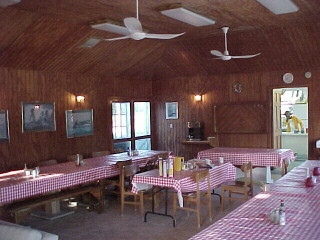
Figure 14. Southwest corner of the dining area.
Ambient air: 76.5oF
Dining area: 77.2oF
Kitchen counter: 78.8oF
A primary reason for heat build up is the refrigeration loads in the kitchen area (Figure 15). The refrigerators on the island vary greatly in age and efficiency. Some are much newer (in the apartments), while others are old (kitchen and lounge). The soda and beer refrigerators in the Lounge are aging and likely inefficient. The refrigerators in both the kitchen and the lounge increase the energy load, and the ones in the kitchen dump large amounts of heat into that area, increasing discomfort:
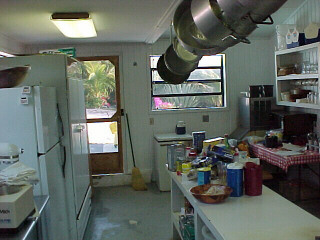
Figure 15. Interior of kitchen facilities
Excellence (Deluxe) 5.5 ft3 freezer ($23 annual energy use label)
0.0 amps off; 4.5 amps on cycle = 558 W
Crystal Tips Ice Maker (largest refrigeration load; large heat build up in NE corner)
0.0 amps off; On = 12.0 - 13.7 amps = 1490 - 1700 W
Magic Chef Refrigerator (RB19HN-2A);
2 amps; On = 248 W
Beverage Air Refrigerator (30 ft3 case refrigerator)
Fan only: 1.1 amps = 136 W
On: 8.4 amps = 1042 W
Recommendation: A well ventilated outside room should be added on the north side of the kitchen with swing doors that contain the refrigerators separate from the kitchen area. A vented range hood should be provided over the cooking area. This is an important fire safety feature and will also significantly reduce heat build-up in the kitchen. When new refrigerators are purchased for the island, the most efficient units of the size and type required should be specified.(5)
VIP (Scientists' Quarters)
There are four units in the facility with double bunk beds (Figure 16). The attic area above has roughly R-11 insulation installed. A sliding glass door in each unit faces south towards the ocean. There is no overhang and this produces major sensible heat gain in the rooms. Each room has a small window air conditioner and several incandescent lights (typically 60 W).
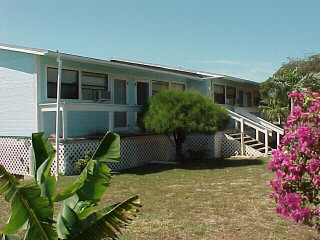
Figure 16. VIP quarters.
The bathrooms have a sink and shower. Measured shower and faucet flow rates in the rooms:
Faucet = 10 liters/minute
Shower = 4.6 liters/minute
This building is to be extensively monitored within the project to see how energy and water consumption can be modified by a series of system improvements.
Recommendation: A large porch/overhang is to be constructed on the south side of the scientists' quarters to keep solar radiation off the large glazed areas and walls. The room AC units will be placed on a door/occupancy sensor system so that the units are deactivated when no one is in the room for more than thirty minutes. Compact fluorescent lighting is to be installed in lamps and the bathrooms of the quarters to learn how well they might work to reduce lighting electrical loads.
Window Air Conditioners
Constant operation of air conditioners (AC) year round contribute to the electrical load on the island. All AC units (except lab and climate control lab) are window or wall units (Figure 17). The lack of distribution losses make window units more efficient. Also, replacement is relatively cheap and repair is not as complex and can be accomplished by island occupants. The replacement rate is about 10 per year (which means that the AC mean time to failure is approximately 3.0 years). Corrosion is a major problem and periodic flushing of AC condenser coils every other month may improve longevity.
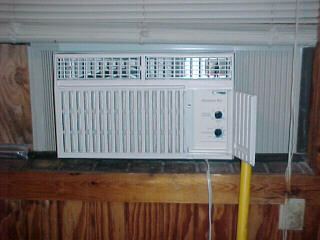
Figure 17. Typical room air conditioner.
There are 32 small window air conditioners in use on the island. There are two primary models in use:
Older units are Fedders:
7,500 Btu, EER = 8.5 Btu/W- 880 W
Fan: Low/High/Off
Cool: Low/Med/High
Newer units are manufactured by Hampton Bay (7,500 Btu) and are purchased from Home Depot for $269 each.
A digital ammeter was used to record AC current draw at 124 Volts:
Hampton Bay:
| Fan only: |
Low: 0.8 A = 99 W Med: 1.0 A = 124 W High: 1.1 A = 136 W |
Cooling: |
Low cool: 5.3 A = 657 W Med cool: 5.4 A = 670 W High cool: 5.5 A = 682 W |
Fedders:
Fan only: |
Low: 0.3 A = 37 W High: 0.6 A = 74 W |
Cooling: |
Low cool: 5.6 A = 694 W Med cool: 6.1 A = 756 W High cool: 6.4 A = 794 W |
Primary mode of operation is to operate the units continuously at low speed. The facilities manager has been told to leave units on continuously since turning them off makes them fail prematurely. However, communication with the Carrier Corporation (Carrier Corp., 1999), who manufactures air conditioners suggests that this is not the case and that periodic flushing of the condenser surfaces with fresh water every other month should be much more important to unit longevity in the Bahamas than turning units on and off.(6) Corrosion is a severe problem with respect to the AC units. Their typical longevity is less than five years. A listing of the AC units and their disposition is given in Table 5 below:
Table 5. LSI Air Conditioning Unit Inventory.
Central AC Systems
-
Main Lab: 4 ton central AC system with air handler
-
Lobster Lab: Central unit, but not in use*
Window Units
| Airport storage building Bay Villa Dive Chamber Dive Shop Office (3) Office Apt Pizza Hut House (2) |
Commissary storage Commissary Apt (2) VIP (4) Bahama House Pink House Chemical Storage Lab Storage |
Generator Storage Rm #1 Generator Storage Rm #2 Hatchery (2)* Cave Apt Long House Beach Cottage (3) Sunrise Inn (2) |
* Seldom used at this time
Recommendations: Turning off units when buildings are unoccupied will not only reduce load, but may extend the life of the units. For the new chemistry lab building, wall and window units should be installed. Central systems should be avoided due to difficulties with repair. Try and buy efficient units where affordable. Units in the office and anywhere else that there is electronic equipment should be left on not only to keep the rooms cool but also to control humidity to prevent degradation of the electronics and books present there. The same is not true in living quarters, however. These units should be turned off when units are vacant. It would be useful to track the installation and failure times of existing units that are installed.
Laboratories
Existing Laboratory
The current lab is a Butler type metal building with a metal roof manufactured by Gulf State. The age of the building is approximately 8 - 10 years. There is concern about the rate of corrosion at this facility. There has also been a frequent leaking of the roof and problems with the air handlers located above the acoustic tile ceiling. Examination of the roof of the lab building shows that the problem is due to the 1/12 roof pitch of the metal roof. The low pitch allows blowing rain to force moisture in around the roof cap. This problem can be avoided with metal roofs in future projects by requiring at least a 3/12 roof pitch for their use.
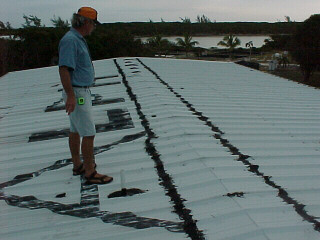
Figure 18. Facilities manager Jim Tryzbiak inspects the roof
of the lab building.
Chemistry Lab
For the new proposed chemistry lab, CMRC is looking for ideas for the construction. The new lab is to be 25 x 50 feet with two fume hoods. It is to be located south of the existing laboratory facility.
Recommendation: Based on the observed termite and corrosion problems on the island, the new facility should be constructed of concrete. This would include a concrete slab, block walls with a concrete roof painted white to reduce cooling needs. The cost of concrete block to the island is $1.23 per block plus $0.75 for shipping. Central air handling units should be avoided due to high costs of operation and difficulties with maintenance. As with the other buildings the following elements should be integral to new facilities:
-
All concrete construction (CBS) with a concrete roof (painted white to reduce heat gain)
-
Integral cistern system for rain water collection
-
Eight foot surround porches around the facility (keeps sun off walls/windows)
-
Tinted double pane windows (controls heat gain/glare)
-
2 kW PV system with inverter to tie system into LSI power grid.
Photovoltaic System
The hill top photovoltaic (PV) system is abandoned (Figure 19). It consists of ninety 50-Watt BP PV modules (BP 104346) in a single large south facing array. Each module measures 37.5 x 17 inches. Twelve additional PV modules of the same type are in storage. The operating modules appear to be in good condition and are generating close to their specified output. Their total output is approximately 4.5 kW (DC). These could easily be tied into an inverter which feeds directly into the island power grid to supplement the diesel generator. During daytime hours they could carry between 10 and 15% of the total electrical load of the island. They would produce about 9,000 kWh per year for a savings in diesel fuel of about 1,000 gallons, worth about $1,000 per year at current prices.
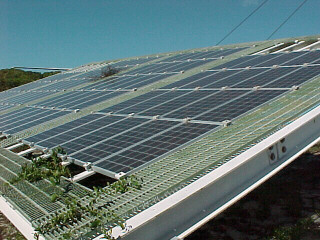
Figure 19. Unused hill top photovoltaic system.
Recommendation: The current PV panels are charging fouled batteries and doing nothing otherwise. They should be wired into the power grid as soon as possible. This would help reduce loads immediately. It is also recommended that PV be considered as a viable power source for future facilities. While it will not meet all the needs of the island, it can considerably reduce diesel fuel usage and therefore consumption. All new buildings or reconstructed facilities should have even 2 kW of PV so as to be self sufficient. It is recommended that 2 kW PV be attached to the new chemistry lab building as a first step.
Roofs
Most of the buildings' roofs have light gray asphalt shingles over plywood decking (Figure 20). The majority of the roofs are A-frame except the lab building, VIP building, and some assorted to storage buildings. Some roofs are in very good condition, while others are in disrepair. Shingle roofs will last less the 15 years in a tropical environment.
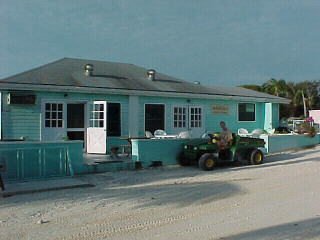
Figure 20. Shingle roof of the kitchen/lounge.
Termites are a significant problem for non-treated wood of any kind on the island and even plywood over treated wood trusses. Metal or concrete roofs are an advantage for the buildings since they can readily be purchased white (reduces cooling), have good longevity and also work well to maintain clean cisterns.
Recommendations: Any time that a roof needs to be replaced it should be replaced by a white metal roof where possible.(7) The roof should be installed properly with all ridge caps and sealants. The roofs of new buildings should be concrete where possible.
Lighting
All lighting at LSI are conventional incandescent or halogen lamps. These are very inefficient. Lights are commonly left on, particularly in the lounge area. There are also a number of overhead lighting systems with T-12 lamps, which are inferior to newer lamps (T8s) in performance. Lighting is more than adequate. For example, every VIP bathroom has a sink light (Figure 21) and shower light, and two lights in the "rec room," as well as a table lamp. There are adequate windows in almost every building to take better advantage of daylighting.
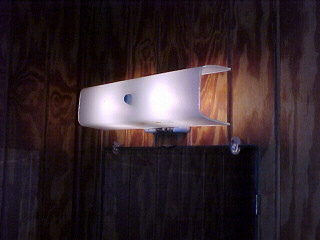
Figure 21. Bathroom sink fixture.
Recommendations: Replacement of all incandescent light bulbs with compact fluorescents (CFLs). The Panasonic SL15 lamp will fit most places which an incandescent will and gives the light of a 60W incandescent for 15W and lasts 10,000 hours rather than the 800 hours for a conventional bulb. These lamps are available in both a standard and globe configuration and cost about $15 each when purchased in quantity. This will reduce maintenance requirements. Replacement should proceed in a natural fashion with incandescent bulbs replaced as they burn out. Replacement of all T-12 magnetic ballast lighting systems should also proceed in a similar fashion with T-8 electronic ballast systems. Switching off lights by visitors when they leave rooms should be strongly encouraged through the use of a reminder located in rooms similar to that already used to help conserve water.
Ceiling Fans
Ceiling fans are often left on, typically drawing about 30 watts at medium speed. Better operational control of fans could easily reduce the average island power draw by about 500 watts (1 amp @480 Volts).
Recommendations: When rooms are unoccupied the ceiling fans should be turned off. They provide no comfort when no one is there and, in fact, add heat to the space. An improved ceiling fan design may soon be available that can increase air circulation with less energy expenditure. Larger 64" fans should replace the three bladed fans in the lounge area (Figure 23).
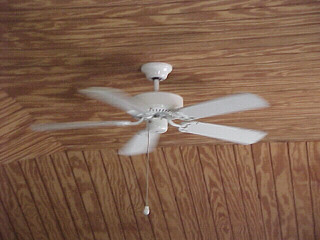
Figure 22. Typical ceiling fan in apartments on LSI.
They are generally always on.
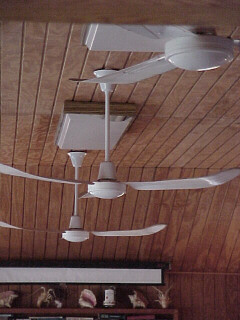
Figure 23. Large ceiling fans located in the lounge.
Termite and Corrosion Problems
Termites are a very serious problem on the island (Figures 24 and 25). The salt water environment also creates a very corrosive circumstance for metals (Figures 26 and 27). Evidence of termite activity is evident in nearly all buildings. The current method of continual spraying and treatment is both expensive, labor intensive and unhealthy. A much better solution is to use termite resistant construction techniques for all future construction.
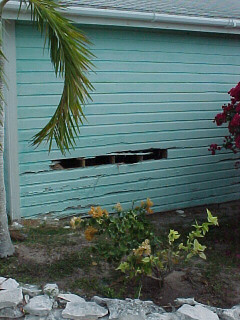
Figure 24. Problems with termites.
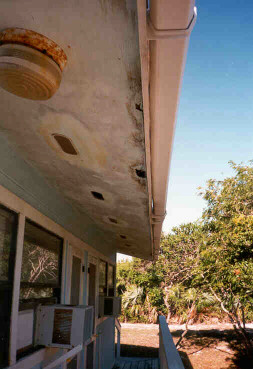
Figure 25. Corrosion and termite damage.
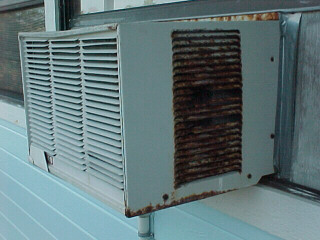
Figure 26. Corroded air conditioner.
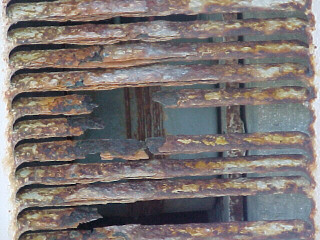
Figure 27. Close-up of corrosion on condenser inlet.
Recommendation: Use all concrete construction in future facilities to avoid both problems with termites and corrosion (metal).
Recommendations for New Construction
New residential construction should follow recommendations as before: concrete block walls, white reflective concrete roof, and energy efficient features. Integral cistern systems should be provided for all new construction. Cooling systems should remain the window/wall type to simplify maintenance. All lighting in kitchens and baths should be T8 fixtures with electronic ballasts or CFLs. In addition to these measures, residences should be constructed similarly to the Hilltop house, with large porches and overhangs that surround the entire building. This will shade the windows and walls and reduce air conditioning.
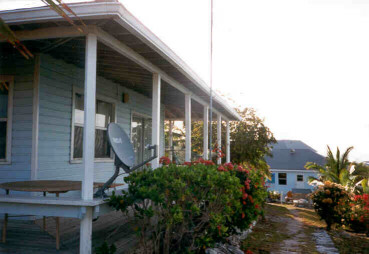
Figure 28. Eight foot surround porch overhang of one of the
residences.
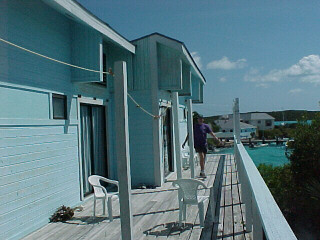
Figure 29. South-facing deck of the VIP showing the exposure
of the walls
and windows to afternoon sunlight. Will be retrofit
with an eight-foot porch.
Refrigerators should be placed in a room away from the main building in a utility room (or in a screened in porch area) to reduce additional heat gain by the appliances and reduce space cooling requirements.
Research Plan
FSEC plans to monitor energy and water use in the VIP living quarters and the kitchen and dining area before and after a series of improvements are made. The characteristics monitored in the VIP's apartment will be room temperature, attic, roof, and decking temperatures, total power use, and AC power use. For the kitchen/lounge, FSEC will monitor interior temperatures, total power use, and ceiling fan/overhead lighting use. Water use will be tracked in both buildings since they share a hot water tank.
Further measurements will include rain water collection by the gutter system into the cistern on the VIP building and water pump power. Diesel fuel consumption will also be carefully tracked as well as power consumed by the reverse osmosis system.
Retrofits will be implemented after a base-line monitoring period. All the VIP quarters will include compact fluorescent lighting (CFL's) in place of the current incandescent and halogen light bulbs. The window air conditioners will be replaced by more efficient units and a white metal roof will be attached to the existing roof. An 8 foot porch will be added to the south ocean-facing exterior of the quarters to shade the sliding glass doors.
Retrofits for the kitchen/lounge will include replacement of the overhead lighting system in the lounge (T-12 with magnetic ballasts) with T-8 electronic ballast lighting systems.
Other improvements on the island will include addition of rain barrel collection for non-potable water use and retrofitting the current water heater that is shared by the Kitchen/Lounge and VIP with a 4 x 8' solar water heater. Impact of the various retrofits will be determined by examining the change in energy and water use before and after the improvements.
Acknowledgments
We would like to thank the staff at Lee Stocking Island for their help with this study and for the hospitality they extended us during our stay on the island. Jim Tryzbiak has been tireless in his assistance both during our stay on the island and with answering our questions while preparing this report. We also thank Dr. Bernhard Riegl who also contributed to our current knowledge of the facility and its scientific mission. We thank Judy Tryzbiak and Eileen Smith for their help and in making our stay on the island a pleasant one.
References
Sonne, J.K., Carribean Marine Research Center Energy Audit, Final Report, FSEC-CR-961-97, submitted to Perry Foundation, Inc., September 1997.
Carrier Corporation, Letter D. Kiely to M. Anello, Florida
Solar Energy Center, April 20, 1999.
1. Our principal contracts during our visit were Bernhard Riegl, the Island Manager and Jim Tryzbiak, Facilities Supervisor. Tryzbiak has been working as facilities supervisor for 2.5 years. The position is very demanding. Noberto Rodriguez is being hired to function as his assistant. Ikemond Black is the island Facilities Technician and is knowledgeable about the plumbing operations.
2. The main difference between the light load and heavy load periods is associated with heavy visitation and air conditioning use. This would indicate that AC and occupancy based loads are approximately 48 kW for the thirty buildings on the island - averageing 1.5 kW for each.
3. It is important to note that this is only the incremental costs of electrical generation based on fuel costs. The cost for overall generation must include the cost of the generation system itself. This is significant as the replaced units had operated for about 29,000 hours (3.3 years; assuming that the daily average power production is at the mid point between the peaks, daily average electricity production is on the order of 1038 kWh). The system would have produced about 1.25 million kWh over its life. The non-amortized cost of the ($17,000) generation system would have added about $0.14/kWh not counting maintenance or the time value of money.
4. Import duties for goods brought in are typically 40% for the Bahamas. CMRC has blanket permit as a research center
5. Refrigerators should be replaced with the most efficient models available as they fail. Information for the appropriate selection is available form the Appliance Manufacturers Association of America which provides rating information on all refrigerators on a semi-annual basis. FSEC has this information and can provide it to CMRC.
6. Letter from Debbie Kiely, Carrier Corporation, to Mike Anello, "Question regarding room air conditioners in the Bahamas", FSEC, April 20, 1999.
7. Inexpensive, white metal 5-vr roofing is available from Southeastern Metals at Home Depot. The approximate cost of the metal roof is $0.80 per square foot. Fasteners, ridge caps and other such details may increase cost to $1.00 per square foot, while the system cost for asphalt shinges is approximmately $0.30.
*Submitted to:
Ed Cobham
Florida Energy Office
2555 Shumard Oaks Blvd.
Tallahassee, FL 32399
